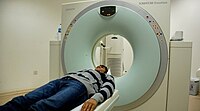
Photo from wikipedia
Introduction and Aim Patients with suspected lung cancer require a prompt histological diagnosis to help plan treatment. Respiratory physicians traditionally obtain samples via bronchoscopy and ultrasound (USS)-guided pleural aspiration. Other… Click to show full abstract
Introduction and Aim Patients with suspected lung cancer require a prompt histological diagnosis to help plan treatment. Respiratory physicians traditionally obtain samples via bronchoscopy and ultrasound (USS)-guided pleural aspiration. Other sampling methods usually rely on interventional radiology and are often a source of delay. In 2014, Kettering General Hospital developed a range of USS-guided procedures performed by physicians in an ambulatory care setting.1 These bedside procedures offered at the initial consultation,2 include sampling of supraclavicular lymph nodes, lung/pleural-based lesions, subcutaneous and bone metastases. This study aims to evaluate the impact of these techniques on histological diagnosis and demand for bronchoscopy and interventional radiology. Methods All patients with suspected lung cancer in the 12 months from January 2016 were reviewed and the histological diagnosis rate was compared to that of 2013 using cancer databases. We identified the method for tissue sampling, and for patients who underwent supraclavicular node sampling, we looked at whether the lymphadenopathy had been reported on by the CT radiologist. Neck ultrasound was carried out if the physician identified any supraclavicular lymphadenopathy on review of CT imaging. Results 238 lung cancers were diagnosed in 2016, with a histology positive rate of 77.2% (Table 1). 51 physician-led bedside ultrasound-guided procedures (excluding pleural fluid aspiration) were carried out in 2016. For those with histology, this comprises 23.8% of histological diagnoses. Of the 23 who underwent sampling of a supraclavicular lymph node, only eight (34.8%) had the nodes mentioned in the CT report. The number of bronchoscopy procedures fell 26.8% and CT guided biopsies fell 19.1%. Conclusion The introduction of these novel physician-led bedside procedures appears to have improved the rate of histological lung cancer diagnosis whilst reducing demand on bronchoscopy and interventional radiology. This study also suggests physicians should seek out supraclavicular lymphadenopathy unless the CT radiologist has commented on their absence. This may reduce the need for more invasive procedures. References . Reddy R, Naeem M, Tsaknis G. S31 safety and yield of physician led ultrasound guided transthoracic lung/pleural biopsies. Thorax2015;70:A23. . Reddy R, Vali Y, Naeem M. P78 tackling emergency lung cancer admissions. Thorax2016;71:A126-A127. Abstract P261 Table 1 2013 2016 Number of confirmed lung cancer (histology positive) 195 (135) 238 (185) Histological diagnosis rate 69.2% 77.7% USS-guided sampling of supraclavicular nodes (Histology positive) 0 23 (19) USS-guided lung biopsy (Histology positive) 0 21 (18) USS-guided sampling of bony/subcutaneous metastases(Histology positive) 0 7 (7) Number of bronchoscopy procedures 183 134 Number of CT guided biopsy procedures 63 51
Journal Title: Thorax
Year Published: 2017
Link to full text (if available)
Share on Social Media: Sign Up to like & get
recommendations!